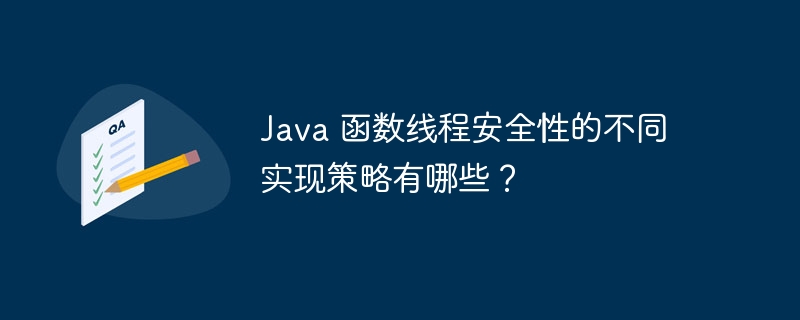Home >Java >javaTutorial >What are the different implementation strategies for Java function thread safety?
What are the different implementation strategies for Java function thread safety?
- 王林Original
- 2024-05-03 21:33:02990browse
The implementation strategies for Java function thread safety include: 1. Synchronized methods, allowing only one thread to execute; 2. Using synchronized code blocks, declaring the lock object as a critical section, and only the thread that obtains the lock object can execute the code; 3. . Use thread-safe collections and data structures provided by the Java concurrency library; 4. Create immutable objects that are inherently thread-safe. These strategies ensure data consistency and program correctness in a multi-threaded environment.

Different implementation strategies to ensure thread safety of Java functions
In a multi-threaded environment, thread safety is crucial to prevent data races and program mistake. For the thread safety of Java functions, there are different implementation strategies as follows:
1. Synchronous method
The synchronized method only allows one thread to execute at the same time, thereby achieving thread safety.
public class SafeCounter {
private int count = 0;
public synchronized int increment() {
return ++count;
}
}2. Use the synchronized code block
synchronized (lockObject) { ... } statement to declare the lock object as a critical section. Within a critical section, only the thread that acquires the lock object can execute code.
public class SafeCounter {
private int count = 0;
private final Object lock = new Object();
public void increment() {
synchronized (lock) {
count++;
}
}
}3. Use the Java concurrency library
java.util.concurrent package provides thread-safe collections and data structures, such as ConcurrentHashMap and AtomicInteger.
import java.util.concurrent.ConcurrentHashMap;
public class SafeCounter {
private ConcurrentHashMap<String, Integer> counts = new ConcurrentHashMap<>();
public int increment(String key) {
return counts.computeIfAbsent(key, k -> 0) + 1;
}
}4. Immutable objects
Immutable objects cannot be modified after they are created, so they are inherently thread-safe.
public final class ImmutableCounter {
private final int count;
public ImmutableCounter(int count) {
this.count = count;
}
public int getCount() {
return count;
}
}Practical Case
Suppose we have a multi-threaded application in which multiple threads need to update a shared counter. By applying these thread-safety strategies, we can create a thread-safe counter implementation:
public class Main {
public static void main(String[] args) {
// 使用不同策略创建线程安全的计数器
SafeCounter counter1 = new SafeCounter();
SafeCounter counter2 = new SafeCounter();
SafeCounter counter3 = new SafeCounter();
// 创建多个线程并发地更新计数器
Thread[] threads = new Thread[10];
for (int i = 0; i < threads.length; i++) {
threads[i] = new Thread(() -> {
for (int j = 0; j < 1000; j++) {
counter1.increment();
counter2.increment();
counter3.increment();
}
});
}
// 启动线程并等待它们完成
for (Thread thread : threads) {
thread.start();
}
// 线程安全策略确保所有线程完成时,计数器包含正确的计数
System.out.println("Counter1: " + counter1.increment());
System.out.println("Counter2: " + counter2.increment());
System.out.println("Counter3: " + counter3.increment());
}
}The above is the detailed content of What are the different implementation strategies for Java function thread safety?. For more information, please follow other related articles on the PHP Chinese website!

